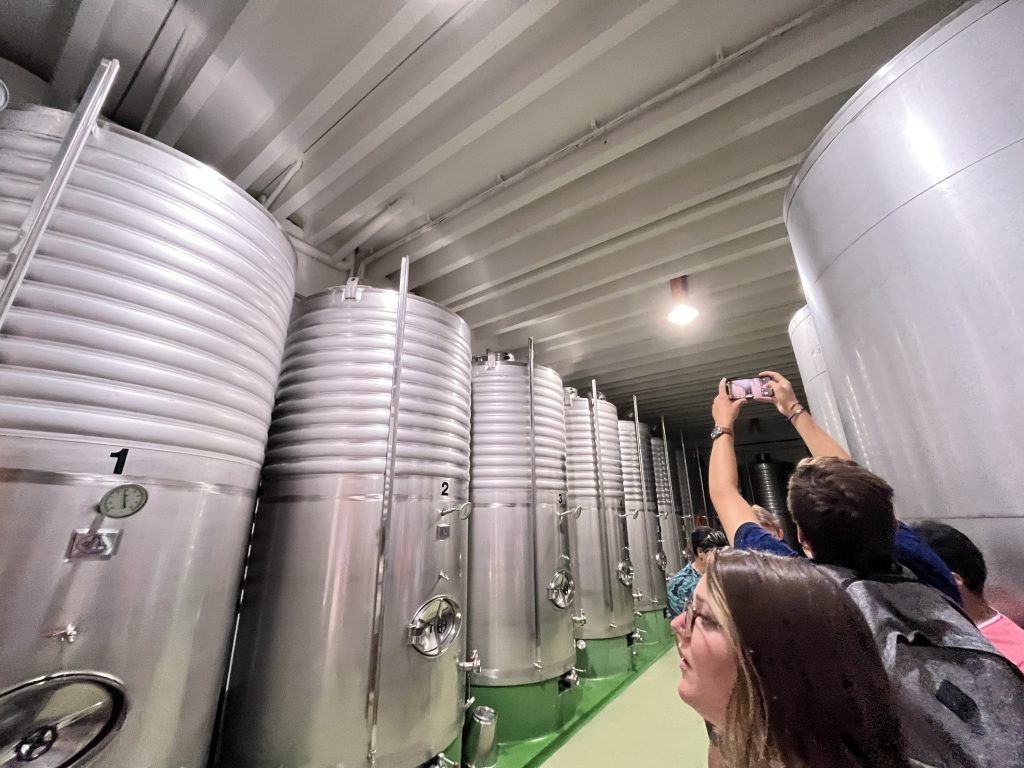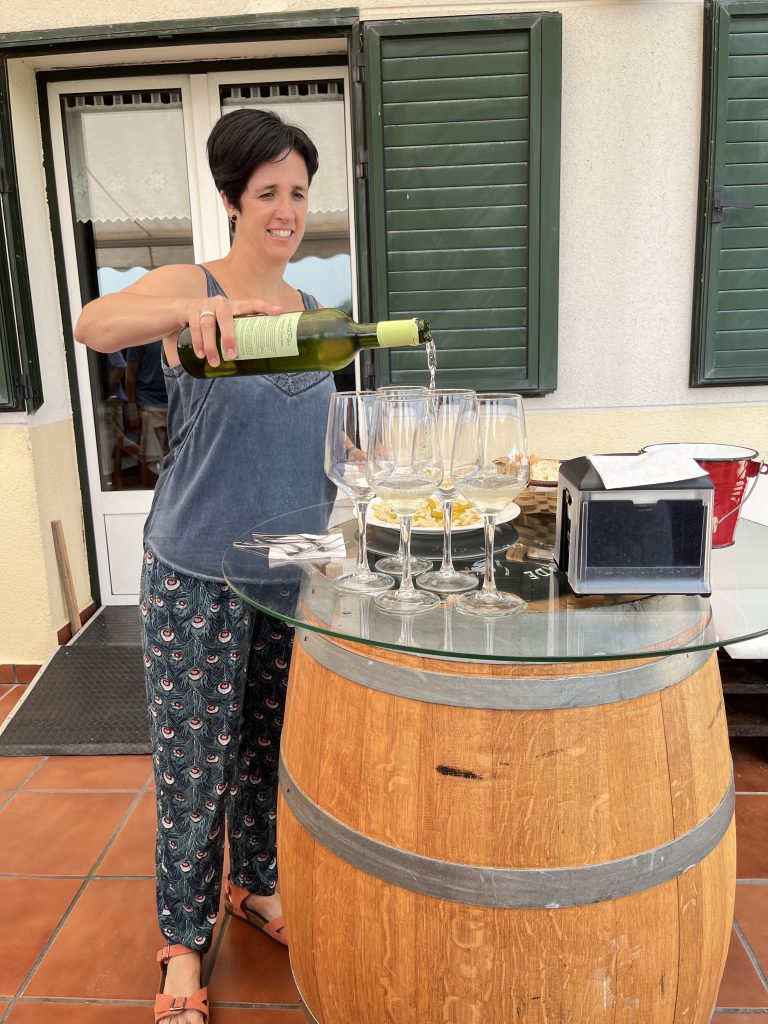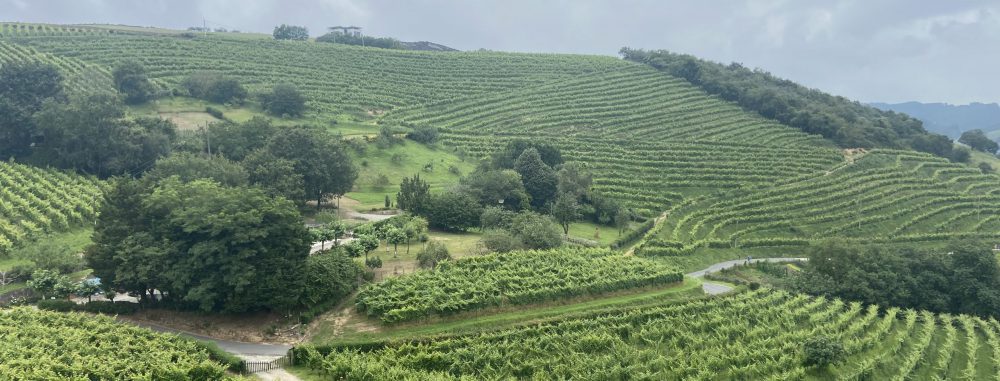When Professor Zabalbeascoa told us that “people’s profile photos are born” at Talai Berri winery in Zarautz, that man was not joking. Today’s winery tour and tasting left us all (mainly thanks to Cate and her photography skills) with a camera roll full of gorgeous photos and, most importantly, happy taste buds.
The History of the Winery
We began the afternoon with a history of the winery, told by one of the two sisters who own and run the winery, and whose family has owned the winery for five generations. Originally the wine was made only for friends and family, but by the third generation they were selling their wine locally, and then to larger populations like Barcelona and Madrid.

The wine produced at this winery, called Txakoli, was given the Denomination of Origin status in 1989, meaning the quality of the product is regulated and guaranteed, and that the grapes used in the wine are grown in that area of the country.
There are three provinces in Basque Country that make this kind of wine, and despite all being sold under the name “Txakoli,” they all have different characteristics based on the ingredients used and the production process. Bizkaia is the main producer of Txakoli, and theirs is much different than the Txakoli produced in Getaria. While the product made in Getaria is a “young” and “fresh” wine meant to be consumed right away, the Txakoli made in Bizkaia has a longer and more complex production process. Bizkaia Txakoli is harvested in September and is in bottles by Christmastime, making the production a very short process.
The Wine Making Process
Each grape used in Talai Berri’s wine is picked off the vine by hand and into crates, which, once they’re filled, are left underneath the vines for a truck to pick up and bring back to the winery. They typically have 16-18 workers picking the grapes from 8am to 3pm each day. The grapes are sent down a chute inside the building and then into a press, which squeezes the juice out. By 5pm that day, the grapes are done pressing and the whole thing starts all over again the next day.
The juice from the very first press of the machine is always the best, while the last squeeze is usually from the skin of the grapes. This last bit of juice is not used in their wine-making process, but instead it is sent out to a distillery where it is made into Grappa.

After the juice is squeezed out, it is sent to a room where temperature-controlled tanks are filled. This is where the natural fermentation begins. Sedimentation occurs in these tanks as particles sink to the bottom, leaving the clean liquid on top. During the last two days of the fermentation process, the tanks are sealed off to trap the natural carbonation inside the wine. This carbonation process is unique to this area, which gives the wine its dryness and acidity.
After this whole process the wine is put into a -40° tank which helps to get rid of any crystals and sediment that may form. They do this there at the winery ahead of time so that crystallization doesn’t occur in consumers’ freezers instead. Finally, the wine is bottled and left to come to room temperature before being labeled. This prevents condensation on the bottle from peeling the label’s adhesive.

Tasting the Wine
The majority of the wine made at Talai Berri is white wine, as the red wine requires exceptional weather and growing conditions. They also produce a rosé, which is actually not as popular here in Europe as it is in the US. Today we were able to try both the white and the rosé.
Most of us have already tasted Txakoli on this trip at restaurants, but I think it was nice, for me at least, to get to slow things down and actually taste the wine rather than simply drink it. Out on the gorgeous terrace of the winery, with a panoramic view of the vineyard and the mountains in the distance, we sipped the wine, ate tuna with peppers and bread and cheese, and enjoyed the taste of Basque.

This particular Txakoli had a crisp taste with notes of apple and lemon. It was cold (as it is meant to be) and refreshing, a perfect wine to drink on a hot, sunny day like today. Julian also taught everyone that white wine glasses are meant to be held by the stem so as not to warm the liquid with your hand.

A Meaningful Trip
Today’s tour was further evidence of the idea we’ve been hearing since before this trip started: that Basque Country is all about modern life intertwining with nature. The fact that Talai Berri’s wine is still made authentically by hand with the same traditional recipe as the first generations of their family’s winemakers (despite using updated technology) proves that the people here value authenticity and quality over convenience. Back in America we seem to gravitate towards the mass-produced food and drink that everyone else around us is also consuming, and that lifestyle simply lacks the charm that the Basque Country possesses in regard to what is consumed and how. Our life in America is so fast-paced and work-oriented, and I think we need to take a page from the Basque Country book and just slow things down to enjoy life.
